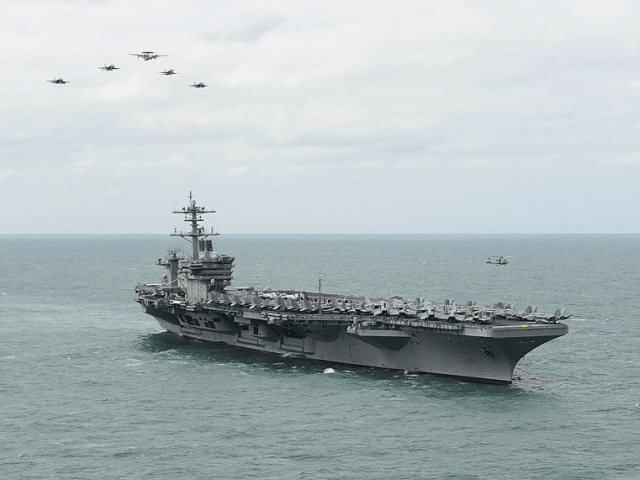The Navy is expediting thousands of sailors off the aircraft carrier USS Theodore Roosevelt in Guam, as about 100 test positive for coronavirus, officials said at a briefing Wednesday.
“We’ll be expediting — people are moving off the ship as we’re briefing right now,” said Chief Naval Officer Adm. Michael Gilday during a Pentagon briefing.
The Roosevelt has come under public scrutiny, after a San Francisco Chronicle report on Tuesday revealed a memo from the ship’s captain on March 30 warning that sailors’ living conditions on and off the ship were not in line with Centers for Disease Control and Navy guidelines. The report also said more than 150 sailors were infected with coronavirus.
Acting Navy Secretary Thomas Modly, who briefed alongside Gilday, said less than 100 of the ship’s 4,865 sailors have tested positive for coronavirus so far and that none of them are seriously ill.
“Not one of them has been hospitalized to date,” he said. “Currently, their numbers are, we have 93 positive tests, 86 exhibiting symptoms and seven without symptoms; 593 negative tests.”
He said so far, 24 percent of the crew has been tested, or 1,273 crew members, though some results have not come back yet.
“We have accelerated testing and are deep cleaning all the spaces on the ship. We are providing the commanding officer what he has requested and we are doing our best to accelerate the pace wherever we can,” he said.
Modly said the captain — identified by the Chronicle as Capt. Brett Crozier — wrote the memo after the ship reached Guam and he felt that there was not enough off-ship spaces for sailors to isolate “at the pace he felt necessary.” He said there was also similar feedback from the medical team aboard the ship, but that the feedback was welcomed.
“We need a lot of transparency, in this process, and we want that information to flow up through the chain of command. And that’s what they did, and we appreciate their ability to let us know at our highest levels, where we can apply resources to help the situation immediately,” he said.
Modly said after hearing their concerns, they began seeking additional space in Guam and elsewhere “right away.”
“We’re making progress on that process. We already have nearly 1,000 personnel off the ship right now. And in the next couple of days, we expect to have about 2,700 of them off the ship,” he said.
He said the Navy was in conversations with Guam to see if there is an ability to free up hotel space for sailors.
Master Chief Petty Officer of the Navy (MCPON) Master Chief Petty Officer Russell Smith said the leaking of Crozier’s memo was not helpful for those assigned to communicate with sailors’ families.
“The [commanding officer] could have communicated in a very different way to avoid family member panicking when the first thing they see or read is not just the letter itself, but the — the spin and the hype and all the things that surround it,” he said.
But he said that in speaking with people that are on the ship that morale “seems high.”
Navy officials said 1,000 sailors would stay onboard the ship to keep it operational and maintain its safety.
“This ship has weapons on it, it has munitions on it, it has expensive aircraft and it has a nuclear power plant. It requires a certain number of people on that ship to maintain the safety and security of the ship,” he said.
Modly said he was not sure how long the Roosevelt would be in Guam, but that if it is needed in a crisis, it could still deploy.
“I would also like to emphasize that if a ship needs to go, if there’s a crisis, the ship can go. That’s part of the reason why we’re maintaining the skills on the ship that we need in case we have to move it in — in the case of an emergency,” he said.
Navy officials say they are still not sure how the virus got onto the ship. The ship made a port visit in Da Nang, Vietnam, approximately 15 days before the first case of coronavirus was detected onboard. They said the visit was conducted since there were only 16 cases of coronavirus in Vietnam further north at the time.
Modly said it is possible that air crew members who were on vacation prior to the ship’s deployment from San Diego in mid-January could have been asymptomatic and brought the virus onto the ship. He also noted that the ship had also stopped in Guam in February.
“Once the virus gets on a ship like that, it’s going to spread and it’s hard to tell where it actually started,” he added.
“So there are other vectors, of course, in which COVID could’ve been introduced to the ship. Understanding exactly who patient zero is is probably going to be an impossible task. So we are doing our very best to prioritize those that are first tested, those that are symptomatic,” he said.
Modly said Navy officials are learning as they go, much like the rest of the country and the world.
“The front lines are constantly being redrawn in this process. Stopping the spread of this virus is the fight we are in right now,” he said.
“Right now, the Teddy Roosevelt is the front-line theater in this new battle, and we have to respond with the skill and agility and direct communication required to protect our people and our nation. I’m confident that the Navy and Marine Corps team will save lives and protect this nation, as it always has and it always will.”
Follow Breitbart News’s Kristina Wong on Twitter or on Facebook.

COMMENTS
Please let us know if you're having issues with commenting.